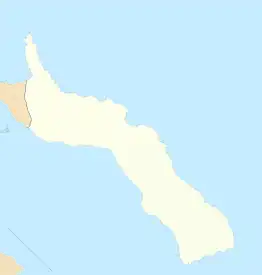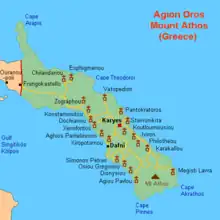Karakallou Monastery
The Karakallou Monastery (Greek: Μονή Καρακάλλου) is an Eastern Orthodox monastery at the monastic state of Mount Athos in Greece. It stands on the south-eastern side of the peninsula and ranks eleventh in the hierarchy of the Athonite monasteries. The monastery has 50 working monks, and its library holds 330 manuscripts, and about 3,000 printed books.
Μονή Καρακάλλου | |
 External view of the monastery. | |
 Location within Mount Athos | |
| Monastery information | |
|---|---|
| Full name | Holy Monastery of Karakallou |
| Established | early 11th century |
| Dedicated to | St. Peter and St. Paul |
| Diocese | Mount Athos |
| People | |
| Founder(s) | Elder Karakalas |
| Prior | Archimandrite Elder Philotheus |
| Important associated figures | Prince of Wallachia John-Peter |
| Site | |
| Location | Mount Athos, Greece |
| Coordinates | 40.2239°N 24.3083°E |
| Visible remains | skull of the Apostle Bartholomew and of St Christopher, and a fragment of the True Cross |
| Public access | Men only |
History
It was founded in the 11th century. In the 13th century, as a result of the activity of pirates and Latins, Karakallou was totally deserted.
By the end of the 15th century according to the Russian pilgrim Isaiah, the monastery was Albanian.[1] The monastery was rebuilt in the 16th century by Moldavian voievod Peter IV Rareș.
Nearby sites
Located near Karakallou Monastery, the Kathisma of St. Efstathios, or Mylopotamos, is a kathisma (cell) belonging to the Monastery of Great Lavra. It was founded by St. Athanasius to serve as a place of convalescence for monks. It is a complex with a defensive tower and vineyards. Patriarch Joachim III of Constantinople, also rested here in the 19th century. Today it is used as a winery and is known for its excellent quality wine.
References
- A. E. Bakalopulos (1973). History of Macedonia, 1354-1833. [By] A.E. Vacalopoulos. p. 166.
At the end of the 15th century, the Russian pilgrim Isaiah relates that the monks support themselves with various kinds of work including the cultivation of their vineyards....He also tells us that nearly half the monasteries are Slav or Albanian. As Serbian he instances Docheiariou, Grigoriou, Ayiou Pavlou, a monastery near Ayiou Pavlou and dedicated to St. John the Theologian (he no doubt means the monastery of Ayiou Dionysiou), and Chilandariou. Panteleïmon is Russian, Simonopetra is Bulgarian, and Karakallou and Philotheou are Albanian. Zographou, Kastamonitou (see fig. 58), Xeropotamou, Koutloumousiou, Xenophontos, Iveron and Protaton he mentions without any designation; while Lavra, Vatopedi (see fig. 59), Pantokratoros, and Stavronikita (which had been recently founded by the patriarch Jeremiah I) he names specifically as being Greek (see map 6).
External links
![]() Media related to Karakalou monastery at Wikimedia Commons
Media related to Karakalou monastery at Wikimedia Commons
